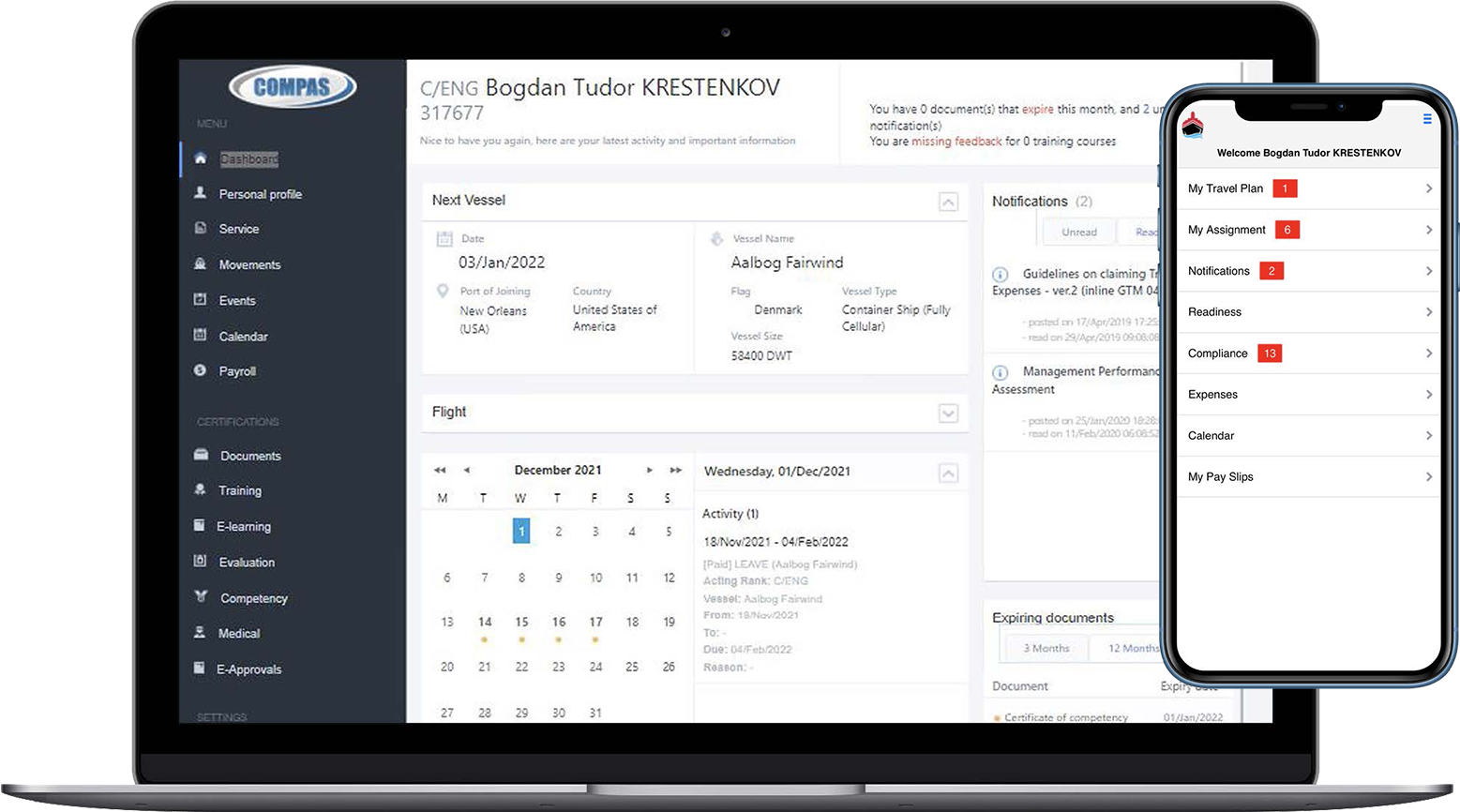As a crucial part of the global economy, the maritime industry is vastly diverse. It encompasses a variety of activities ranging from port operations to shipbuilding to transporting over 80 percent of the world’s goods (think container vessels, oil tankers, etc.) to fishing to cruise ships to offshore energy production – and much more. And all this must be operated by skilled professionals – an estimated 1.9 million people employed at sea only.
No matter if it’s a commercial container ship with 20-30 mariners onboard or a cruise liner operated by 2,000 crew members, people are the backbone of any vessel, so handling crews is a critical aspect of ship management that requires proper administration.
In today’s rapidly digitizing world, technology is capable of streamlining crew-related operations, helping to increase performance and achieving a competitive advantage. So let’s talk about what crew management is about and how to digitize it.
What is crew management for ships?
In the maritime industry, crew management is a range of activities related to overseeing and organizing personnel onboard vessels. It encompasses
- recruitment,
- deployment,
- training,
- scheduling,
- payroll management,
- travel arrangements,
- insurance and health schemes, and so on.
Crew management aims at finding qualified personnel, as well as ensuring safe and efficient operation, crew well-being, and compliance with regulations and company policies.
Who handles crew management?
Typically, there’s no single person responsible for all of the crew management activities (except for smaller vessels like boats or yachts). Depending on the type of vessel and voyage organization, different scenarios are possible. Even within ship chartering, there are various models.
For example, both a voyage charter and time charter agreement usually imply hiring a ship together with the crew (so it’s a shipowner's responsibility to find, train, and deploy personnel, while a charterer takes care of their well-being and safety), but in the bareboat charter, all the crew-related issues are handled by the charterer.
In addition to that, in many cases, HR activities are outsourced to a specialized crew management company.
What is a crew management company?
A crew management company (also called crewing/manning agency) is a third-party organization that provides manning services for fleet owners, vessel managers, or charterers for a commission. Typically, such companies have an international network or pool of seafarers and multiple offices around the world to meet the manning demand of different vessels. Many of them also offer education and training services, as well as certification programs for mariners.
Depending on the agreement scope, crewing agencies can perform all or some of the HR-related activities we listed above, attracting, training, and retaining ship personnel.
Some of the biggest global crewing agencies are V.Group, Anglo-Eastern, Bernhard Schulte Shipmanagement, and OSM Group.
Due to its importance and with so many parties engaged in crew management, streamlining these operations becomes a strategic priority. And it’s only possible through the transition from legacy methods (think pen and paper, fax machines, and manually-filled spreadsheets) to new, integrated technologies that allow executives to intelligently automate workflows. Let’s see how it works.
Vessel crew management software
Crew management software (CMS) is the digital platform that helps optimize all HR-related processes of companies that operate in the maritime industry. Such systems are designed to minimize the administrative workload, reduce paperwork, support crew-related decisions, and ensure compliance with ISM, MLC, STCW, and other maritime regulations.
CMS can be used by both shipping businesses that actually operate fleets and crew management companies. Let’s look at the core functionality of CMS.
Main crew management software features
Crewing (recruitment)
Selecting the best candidates is a challenge in any industry. The recruitment module of the CMS helps create talent pools and select seafarers that best fit the requirements of a specific vessel. Most CMS products also consider the oil industry specifics and allow you to work with crewing matrices (complex, labor-intensive documentation related to oil majors requirements from OCIMF).
Applicant management capabilities facilitate the process of adding new specialists to the pool by auto-processing incoming CVs. Follow-up procedures can also be automated to reduce the HR workload.
In addition, crew deployment can be optimized with bulk registering functionality as personnel goes through a safety briefing and other pre-departure procedures.
Planning and scheduling
It’s equally important to strategically plan the manning needs of the vessel/fleet and also to create fair, efficient schedules to ensure optimal crew utilization and proper ship operation. Both of these aspects include a multitude of factors that have to be considered (e.g., business objectives, available resources, people skills, financial restrictions, and other hard and soft constraints), so doing it manually is just too complicated.
Crew management software helps plan the optimal number of personnel and their composition depending on the vessel type, journey duration, logistics requirements, etc.
It can also create a crew rotation schedule considering crew skills and competencies, work/rest hours requirements (STCW 2010, OPA-90, and other regulations), and various personal preferences. Vacations and sick leaves can also be added.
MINTRA OCS HR crew rotation module
CMS allows planners to conveniently view schedules by location, crew, vessel, or other criteria.
Importantly, modern CMS is able to handle the international date line crossing and automatically adjust time according to the geographic location.
Payroll
In any business, a key to staff retention is salaries paid out accurately and on time. In the maritime world, though, it gets more complicated since the crew is usually multinational, so payroll management involves dealing with multiple currencies, wage scales, tax regimes, accounts, and pension deduction schemes. In addition, there are different payroll reporting requirements in every country.
All these complexities make the payroll module tailored to the maritime industry an essential component of any CMS. It helps automate wage-related operations, reduce human error, and ensure compliance. In addition to salary calculation, it also helps handle other crew-related expenses like overtime, leave pay, cash to master, allotment, etc.
Crew database and documentation management
CMS serves as a complete database of all crew-related information. It includes such data as
- personal employee details (name, address, contact details, next of kin, emergency contact name and number, etc.);
- contract information;
- information about past employment, career development, and appraisals;
- payroll data;
- medical history;
- rota schedules;
- education and training certificates;
- related business expenses data; etc.
These records are crucial for allocating tasks, reviewing performance, checking eligibility, tracking licenses, filling out various documentation (reports, safety management system compliance, etc.), and so on.
And it’s not only about keeping or retrieving data when necessary. For example, CMS helps generate contracts for different positions. It can also be configured to automatically send alerts when, say, the expiry date of a seaman certificate is approaching.
Note that a CMS database must be compliant with data security regulations like GDPR.
Compliance reporting
To enhance safety and aid operations, the maritime industry is subject to compliance from many regulators – from IMO to national and port authorities. Multiple reports must be submitted, but filling them out takes too much time.
CMS and other tech solutions help with data collection and reporting procedures. As we said, since all crew-related data (performance, expenses, work/rest hours, etc.) is stored in a single system, it becomes easier to fill out reports and submit them online. As a result, time spent and human error are reduced, thus increasing operational efficiency.
Analytics
In addition to industry regulations, internal reporting is crucial for enhancing business intelligence. More and more companies today collect and analyze data to find areas for improvement and support decision-making, and technology plays a key role in this process.
Other useful modules that are often part of the CMS can include insurance management, corporate travel arrangement, skill assessment, learning solution, and so on.
Often, a crew self-service portal is also created to give seafarers access to their data via a dedicated app.
Crew management software integrations
Crew management software can come in various forms. It can be a standalone solution or a part of the comprehensive fleet management system. You can also opt for implementing only a certain module, e.g., just a payroll or a scheduling tool.
In any case, though, it’s essential to build connections between all the parts of your IT ecosystem to enable seamless data exchange. For example, the CMS must be integrated with an accounting tool to share payroll information and other financial data. If you only utilize separate focused modules, connect them to the database of your main business application to store and exchange all the necessary information.
If you operate a crewing agency, consider building a connection with your website so that candidates’ applications get directly to your database.
External integrations also help conveniently exchange data. If you work with travel agents to arrange crew transfers and repatriation, it’s worth integrating with their system so that you can easily share booking requests with all the necessary details, track their status via your system’s interface, manage invoices, etc.
Buy or build?
If you think about implementing an industry-specific solution to manage your crew, you inevitably encounter the question of whether you should buy a ready-made product or build your own. As we said above, the software market today has a range of offerings, from separate focused modules to multifunctional CMS to full-blown fleet management systems with crew-related functionality included.
Obviously, every business is different and has unique business needs. When making a decision, you first have to assess your existing IT infrastructure, define the workflows that most require automation, and evaluate your resources.
Building a custom product from scratch is a large project that requires significant investment. However, the benefit is obvious – you get your own software tailored to your specific business needs. So if you run a crewing agency and these HR activities are your primary business focus, it’s worth going this way and developing a proprietary platform that will perfectly cover all your workflows, thus increasing efficiency.
In the meantime, if you operate, say, a mid-size shipping company and just want to enhance your fleet management with a couple of specialized crew or payroll-related modules, it makes more sense to get a focused off-the-shelf product (just remember about the integration!).
Crew management software providers
Here are some of the providers that offer robust crew management solutions that you can check out (the described systems are for overview purposes only; we don’t aim to promote any of the vendors).
Ocean Technologies Group with its COMPAS – a multifeatured platform with payroll functionality, insurance tools, a range of reporting dashboards, and a crew portal. There's also a travel management system that comes preintegrated with external travel agents via APIs.
Soft-Team’s OMEGA – a modular system that helps handle crewing, payroll, and job applications. It also has a crew portal and a tanker vessel module integrated with Q88 and OCIMF. There are a number of add-ons like a flight request module, a dashboard analyzer, gangway control, video guides, and more. OMEGA comes fully integrated with Sertica – a popular fleet management platform.
SHIPMATE by SBN Technologics is a suite of tools that covers all vessel management aspects and includes such modules as Crew Management and Payroll, Crew Competence Management, and Crew Work and Rest Hours. These modules cover all the essential workflows (travel arrangements, insurance, scheduling, appraisal management, reporting, etc.). There are multiple external integrations with travel agents, banks, training systems, etc. A seafarer’s portal is available as well.
BASSnet is another provider of ERP maritime solutions offering a robust Crew and Payroll Management module – that supports all the key HR operations including planning, scheduling, training, travel booking, etc. There’s also a Stores feature that allows for selling items from bonded stores to the crew with a deduction from their salaries. This solution comes preintegrated with bank systems and includes a connected crew self-service app.
DNV, an international accredited registrar and the world's largest classification society that has been operating since 1864, also provides a variety of digital solutions for maritime, energy, and other industries. ShipManager Crewing, a part of their ShipManager maritime software suite, is designed to support such processes as crewing, deployment, payroll, planning, scheduling, data collection, and reporting.
The maritime industry is known as a relatively slow adopter of innovative tech solutions. Many companies operate on legacy systems and are reluctant to invest in modernization. However, if you want to sail toward greater efficiency, now is the time to embrace digitization in all aspects of fleet management both at sea and on the shore – crew management included.

Maria is a curious researcher, passionate about discovering how technologies change the world. She started her career in logistics but has dedicated the last five years to exploring travel tech, large travel businesses, and product management best practices.
Want to write an article for our blog? Read our requirements and guidelines to become a contributor.

